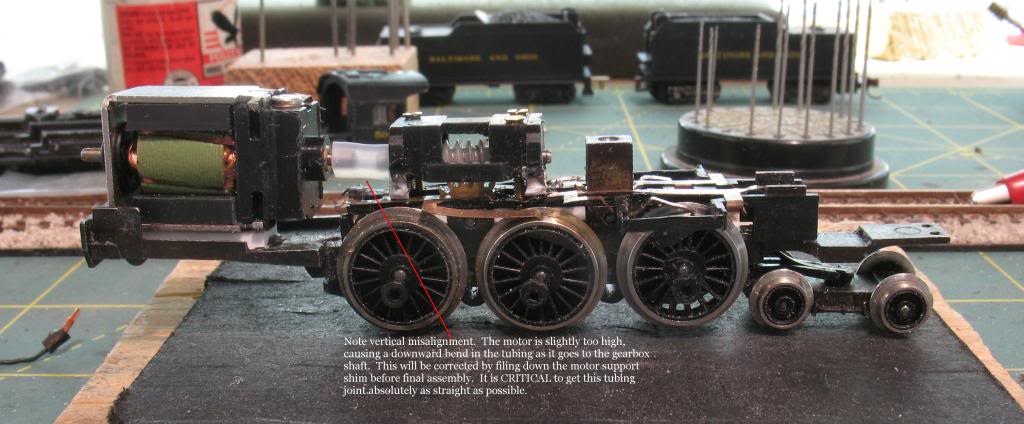Folks,
I've been beavering away on remotoring an old Arnold Rapido 4-6-2 Pacific. This was experimental in nature, and
I was asked to delve into it by a few people. The goal was to replace the old motor with something inexpensive
and commonly available, and come up with better, smoother performance than the original.
This long-winded intro will lead to several questions I have about why the mechanism is behaving the way it is, and
more general philosophical questions about motor behavior and how to set up a driveline. If you are interested in such matters,
read on.
If not... next thread!

I'm hoping this opens up contribution of good opinion and knowledge on this stuff.
Here's a photo of what I have in it now:

Please ignore the obvious misalignment of the rubber tube. This photo was taken before I had the motor properly
shimmed and permanently screw-mounted to the frame. That has long since been corrected.
The worm carrier is from a Bachmann H16-44. It is a plastic worm, and it has plastic washers on each
end of it inside the housing. The worm axle just rides in the plastic housing. There are no bronze bearings.
The motor is the venerable old 1990s Lifelike diesel motor. 5-pole, skew-wound, open frame. And if you know this motor,
you know it has the power of a bull, and pretty darn good low end performance.
They are linked by a piece of silicon rubber aircraft fuel line tube. It is very flexible and very grippy.
So, after carerfully adjusting the mount and watching the old ammeter, with the engine running free on
the workbench, I got the current draw at 6v down from about 75ma to
about 52ma. And given that the motor draws 40ma when it is running free in your hand, I though that was doing
mighty good for an ancient mechanism with axle bearings, big chunky gears, and wipers on the driver tops.
After I used a Dremel to cut off the back motor shaft, doing it carefully and very slowly so that it didn't heat up,
I noticed that it didn't quite run as well. Then I realized that one of the magnets had come loose in the motor housing
(a common problem with this LL motor)
So I repositioned and glued the magnet, and Bob's your uncle, it ran very nicely again.
I ran it overnight at 6v as a torture test.
In the morning, it had stopped. The wheels were not stuck. All the gears were free.
I nudged the armature, and off it went, running again. I let it spin at a variety of voltages, and it seemed
to be running fine.
*****************************************************
Here, the round-table questions begin:
*****************************************************
1. Why did it stop? It wasn't running anywhere near it's "minimum" speed, meaning I had watched it on the bench
for more than an hour and it was spinning at 6v well above where it even *thinks* about stopping.
Perhaps a chunk of brush in the commutator? Don't know.
After I got it running again, it runs, but is back to drawing around 75ma, not 50. And at 12v, it draws about 100ma,
whereas before, it was more like 70.
In spite of this, it does not get even warm, and it just gets better and better. It is now so smooth that it
can sustain speeds under 5 scale mph (on the bench, that is, computing it by the driver revolutions).
It couldn't do anywhere near that good a day ago.
2. So, what's with the higher current? Usually, motors wear in, smooth out, and the current drops. Perhaps
the brushes and comm have worn in a little, are making better contact, the motor is making more power, but it's drawing
more current to do it? If so, I have no problem with that.
3. What about that rubber tube drive?I did try a NWSL cup and ball, but I could not get it to run as well as the tube, and there isn't enough room for a full
universal with dual cups. It does occur to me, however, that the rubber tube effectively joins the
worm shaft and the motor shaft into one continuous piece, lengthwise. Perhaps that is a drawback.
As the engine runs, and the worm pushes on the idler gear to drive the engine, the worm is thrust one way or
the other in its housing against its plastic washers, and because of the way the motor is connected,
the armature is also forced in that direction. I don't see how that's any worse than a normal worm drive, where
the arm is pushed that way. Is there more to this that I don't see? Opinions.
So there it is, motor nuts and mechanism fools. I welcome all advice, commentary, and suggestions. Just
stencil them on the back of a Steinway Model "O" grand piano and mail to....